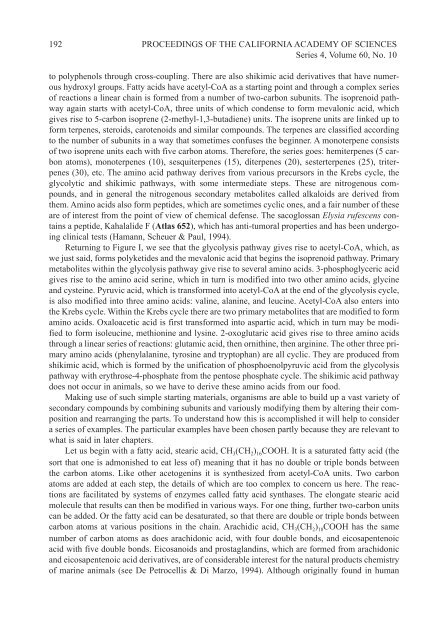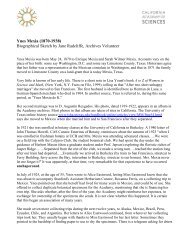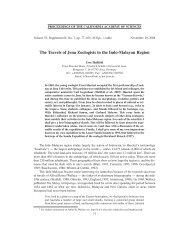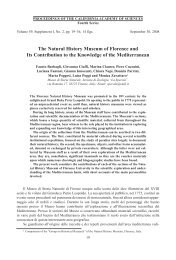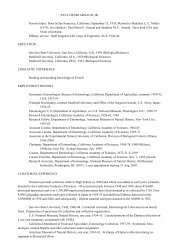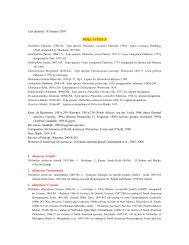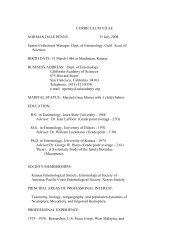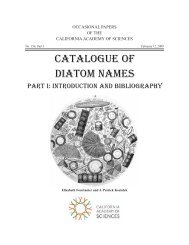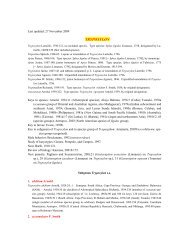Cimino&Ghiselin-tmpZXYZ:Template Proceedings_1.qxd.qxd
Cimino&Ghiselin-tmpZXYZ:Template Proceedings_1.qxd.qxd
Cimino&Ghiselin-tmpZXYZ:Template Proceedings_1.qxd.qxd
Create successful ePaper yourself
Turn your PDF publications into a flip-book with our unique Google optimized e-Paper software.
192 PROCEEDINGS OF THE CALIFORNIA ACADEMY OF SCIENCES<br />
Series 4, Volume 60, No. 10<br />
to polyphenols through cross-coupling. There are also shikimic acid derivatives that have numerous<br />
hydroxyl groups. Fatty acids have acetyl-CoA as a starting point and through a complex series<br />
of reactions a linear chain is formed from a number of two-carbon subunits. The isoprenoid pathway<br />
again starts with acetyl-CoA, three units of which condense to form mevalonic acid, which<br />
gives rise to 5-carbon isoprene (2-methyl-1,3-butadiene) units. The isoprene units are linked up to<br />
form terpenes, steroids, carotenoids and similar compounds. The terpenes are classified according<br />
to the number of subunits in a way that sometimes confuses the beginner. A monoterpene consists<br />
of two isoprene units each with five carbon atoms. Therefore, the series goes: hemiterpenes (5 carbon<br />
atoms), monoterpenes (10), sesquiterpenes (15), diterpenes (20), sesterterpenes (25), triterpenes<br />
(30), etc. The amino acid pathway derives from various precursors in the Krebs cycle, the<br />
glycolytic and shikimic pathways, with some intermediate steps. These are nitrogenous compounds,<br />
and in general the nitrogenous secondary metabolites called alkaloids are derived from<br />
them. Amino acids also form peptides, which are sometimes cyclic ones, and a fair number of these<br />
are of interest from the point of view of chemical defense. The sacoglossan Elysia rufescens contains<br />
a peptide, Kahalalide F (Atlas 652), which has anti-tumoral properties and has been undergoing<br />
clinical tests (Hamann, Scheuer & Paul, 1994).<br />
Returning to Figure I, we see that the glycolysis pathway gives rise to acetyl-CoA, which, as<br />
we just said, forms polyketides and the mevalonic acid that begins the isoprenoid pathway. Primary<br />
metabolites within the glycolysis pathway give rise to several amino acids. 3-phosphoglyceric acid<br />
gives rise to the amino acid serine, which in turn is modified into two other amino acids, glycine<br />
and cysteine. Pyruvic acid, which is transformed into acetyl-CoA at the end of the glycolysis cycle,<br />
is also modified into three amino acids: valine, alanine, and leucine. Acetyl-CoA also enters into<br />
the Krebs cycle. Within the Krebs cycle there are two primary metabolites that are modified to form<br />
amino acids. Oxaloacetic acid is first transformed into aspartic acid, which in turn may be modified<br />
to form isoleucine, methionine and lysine. 2-oxoglutaric acid gives rise to three amino acids<br />
through a linear series of reactions: glutamic acid, then ornithine, then arginine. The other three primary<br />
amino acids (phenylalanine, tyrosine and tryptophan) are all cyclic. They are produced from<br />
shikimic acid, which is formed by the unification of phosphoenolpyruvic acid from the glycolysis<br />
pathway with erythrose-4-phosphate from the pentose phosphate cycle. The shikimic acid pathway<br />
does not occur in animals, so we have to derive these amino acids from our food.<br />
Making use of such simple starting materials, organisms are able to build up a vast variety of<br />
secondary compounds by combining subunits and variously modifying them by altering their composition<br />
and rearranging the parts. To understand how this is accomplished it will help to consider<br />
a series of examples. The particular examples have been chosen partly because they are relevant to<br />
what is said in later chapters.<br />
Let us begin with a fatty acid, stearic acid, CH 3(CH 2) 16COOH. It is a saturated fatty acid (the<br />
sort that one is admonished to eat less of) meaning that it has no double or triple bonds between<br />
the carbon atoms. Like other acetogenins it is synthesized from acetyl-CoA units. Two carbon<br />
atoms are added at each step, the details of which are too complex to concern us here. The reactions<br />
are facilitated by systems of enzymes called fatty acid synthases. The elongate stearic acid<br />
molecule that results can then be modified in various ways. For one thing, further two-carbon units<br />
can be added. Or the fatty acid can be desaturated, so that there are double or triple bonds between<br />
carbon atoms at various positions in the chain. Arachidic acid, CH 3(CH 2) 18COOH has the same<br />
number of carbon atoms as does arachidonic acid, with four double bonds, and eicosapentenoic<br />
acid with five double bonds. Eicosanoids and prostaglandins, which are formed from arachidonic<br />
and eicosapentenoic acid derivatives, are of considerable interest for the natural products chemistry<br />
of marine animals (see De Petrocellis & Di Marzo, 1994). Although originally found in human


